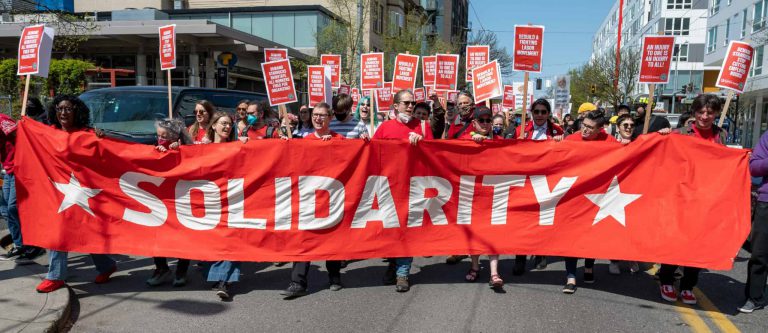In Illinois politics and labor relations, changing circumstances have transformed friends into enemies and back again in just the past six months. Specifically, unions have come to the aid of Governor Pat Quinn’s reelection effort, endorsing him and investing millions in his campaign, just months after suing him for an “abdication . . . of [his] most fundamental duty” and threatening to sit out the general election. How did this happen?
First, Illinois has faced a pension shortfall for years. According to the Associated Press, “Illinois’ $100 billion shortfall in funding employee retirement benefits is considered the worst pension crisis in the nation. For decades, while other states dealt with similar problems, Illinois lawmakers and governors skipped or shorted payments to their state’s five pension systems. It led to repeated downgrades of the state’s credit rating and diverts millions of dollars from education and social programs.”
Consequently, Democratic Governor Quinn and other elected officials in the state made pension reform a priority. Until December 2013, however, attempts to enact substantial changes “went nowhere,” despite “special legislative sessions in Springfield, [the state capital], a social media campaign and even a failed attempt to withhold lawmakers’ salaries until they acted.” The vehement opposition by organized labor to cuts to the benefits that they had negotiated for their members was one key reason for inaction. Quinn himself was endorsed by public sector unions in 2010, and received “solid support” from union households in that election, which he won by an extremely narrow margin. Yet, in December 2013, the General Assembly passed and Governor Quinn signed a “landmark” reform bill, which cut “benefits for most employees and retirees,” but “is expected to save the state roughly $160 billion over three decades” and is projected to “fully fund the retirement systems by 2044.”
Unsurprisingly, unions and their allies strongly opposed the new law; according to Illinois House Speaker Michael Madigan, “[u]nion opposition was a big obstacle to securing votes.” In fact, a union group, We Are One Illinois, described the legislation as an “unfair, unconstitutional scheme.” They called on Quinn to veto the reform, saying “our union coalition will have no choice but to seek to uphold the Illinois Constitution and protect workers’ life savings through legal action” if he signed it. Gov. Quinn approved the legislation, and true to their word, a coalition of unions took the matter to court. The lawsuit by “the AFL-CIO, Illinois Education Association, Illinois Federations of Teachers, AFSCME Council 31, SEIU Local 73 and other unions . . . alleges the pension law that proponents said would ease the state’s $100 billion pension crisis violates the pension clause of the state Constitution, which says public pensions can’t be diminished or impaired.”
The harsh words union leaders had for Quinn – for example, the President of the Illinois AFL-CIO said, “[t]he Legislature and governor shirked their responsibility to uphold the Constitution, so we are seeking justice in court to right their wrongs” – suggested that they might look to support another candidate in the 2014 elections, or at least not actively support Quinn. Yet, by the end of March, Quinn garnered major union endorsements, and “[h]is biggest donations” for his $4.5 million campaign fund “came from labor unions.” What changed?
One of the leading Republican primary candidates, Bruce Rauner, ran on an aggressively anti-union platform. For example, in his campaign announcement, Rauner criticized “government union bosses,” blamed unions for the state’s financial woes, and suggested labor leaders are “corrupt.” In the end, “unions spent more than $6 million on the [Republican] primary” to defeat him.
While the labor efforts appeared to narrow Rauner’s lead – his double digit advantage shrank to just two percentage points on election day – he ultimately prevailed, becoming the Republican nominee. As a result, “union leaders have begun bracing for one of their starkest campaign battles of the year over the fate of public sector labor unions, pensions and pay,” and labor’s disappointments with Gov. Quinn have taken a backseat to a more important imperative: “redoubl[ing] their efforts to prevent Mr. Rauner’s election in November.”






Daily News & Commentary
Start your day with our roundup of the latest labor developments. See all
April 17
Utahns sign a petition supporting referendum to repeal law prohibiting public sector collective bargaining; the US District Court for the District of Columbia declines to dismiss claims filed by the AFL-CIO against several government agencies; and the DOGE faces reports that staffers of the agency accessed the NLRB’s sensitive case files.
April 16
7th Circuit questions the relevance of NLRB precedent after Loper Bright, unions seek to defend silica rule, and Abrego Garcia's union speaks out.
April 15
In today’s news and commentary, SAG-AFTRA reaches a tentative agreement, AFT sues the Trump Administration, and California offers its mediation services to make up for federal cuts. SAG-AFTRA, the union representing approximately 133,000 commercial actors and singers, has reached a tentative agreement with advertisers and advertising agencies. These companies were represented in contract negotiations by […]
April 14
Department of Labor publishes unemployment statistics; Kentucky unions resist deportation orders; Teamsters win three elections in Texas.
April 13
Shawn Fain equivocates on tariffs; Trump quietly ends federal union dues collection; pro-Palestinian Google employees sue over firings.
April 11
Trump considers measures to return farm and hospitality workers to the US after deportation; Utah labor leaders make final push to get the “Protect Utah Workers” referendum on the state’s ballot; hundreds of probationary National Oceanic and Atmospheric Administration employees were re-terminated